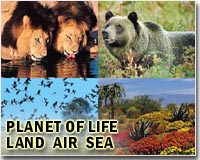 |
Washington DC (SPX) Feb 07, 2011 Things are not always what they seem when it comes to fish-something scientists at the Smithsonian Institution and the Ocean Science Foundation are finding out. Using modern genetic analysis, combined with traditional examination of morphology, the scientists discovered that what were once thought to be three species of blenny in the genus Starksia are actually 10 distinct species. The team's findings are published in the scientific journal ZooKeys. Starksia blennies, small (less than 2 inches) fish with elongated bodies, generally native to shallow to moderately deep rock and coral reefs in the western Atlantic and eastern Pacific oceans, have been well-studied for more than 100 years. It would have been reasonable to assume that there was little about the group left to discover. Modern DNA barcoding techniques, however, suggested otherwise. While trying to match larval stages of coral reef fish to adults through DNA, the team of scientists noticed contradictions between the preliminary genetic data and the current species classification. Further investigation revealed that the team was dealing with many species new to science, including the new Starksia blennies. "DNA analysis has offered science a great new resource to examine old questions," said Carole Baldwin, a zoologist at Smithsonian's National Museum of Natural History and lead author of the paper. "This discovery is a perfect example of how DNA barcoding is illuminating species that we've missed before, particularly small cryptic reef fishes like Starksia blennies. We don't know where we stand in terms of understanding species diversity, and our work suggests that current concepts may be surprisingly incomplete." But DNA analysis cannot stand on its own-Baldwin and her team only recognize genetic lineages as species if they are supported by morphology. So traditional morphological analysis, such as comparing patterns of pigmentation and numbers of fin rays, is conducted to solidify their findings. One interesting aspect of the research is that Starksia species that were thought to be broadly distributed throughout the Caribbean-as most Caribbean reef fish species are-break up into multiple species with geographically restricted ranges. One species in the study, for example, was divided into three-a species in the east (Bahamas/Turks and Caicos), one in the south (Curacao, Netherlands Antilles) and another in the west (Belize, Central America). Baldwin predicts that other widespread species in the genus may also represent species complexes that break into multiple, geographically distinct species after further study. Furthermore, the team's DNA data suggest that other types of Caribbean fish (e.g., some gobies) may similarly represent species complexes comprising numerous new species, and traditional concepts of speciation in the Caribbean may need to be re-evaluated. The team's combined molecular and morphological approach has not only increased the number of currently recognized species, it serves as an example of the continuing nature of scientific discovery. Because the resiliency of marine populations to human exploitation may be linked to species richness, an improved understanding of the diversity and distribution of deep-reef life may be critical.
Share This Article With Planet Earth
Related Links Smithsonian Darwin Today At TerraDaily.com
 Study shows extinction 'domino effect'
Study shows extinction 'domino effect'Wellington, New Zealand (UPI) Feb 4, 2011 New Zealand researchers say the local extinction of two bird species a century ago is linked to the present decline of a common forest shrub. Scientist at the University of Canterbury say the disappearance of two pollinating birds - the bellbird and stitchbird - from the upper North Island of the country has led to a slow decline in common plants including the New Zealand gloxinia in ... read more |
|
| The content herein, unless otherwise known to be public domain, are Copyright 1995-2010 - SpaceDaily. AFP and UPI Wire Stories are copyright Agence France-Presse and United Press International. ESA Portal Reports are copyright European Space Agency. All NASA sourced material is public domain. Additional copyrights may apply in whole or part to other bona fide parties. Advertising does not imply endorsement,agreement or approval of any opinions, statements or information provided by SpaceDaily on any Web page published or hosted by SpaceDaily. Privacy Statement |